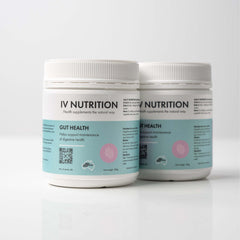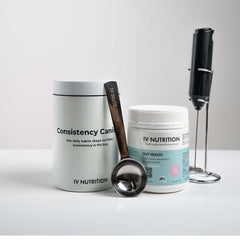Acid reflux is more than a fleeting discomfort—it’s a physiological signal that your digestive system is under duress. Known clinically as gastroesophageal reflux disease (GERD) when it becomes chronic, acid reflux affects approximately 20% of U.S. adults each week. It manifests as heartburn, regurgitation, chest tightness, and sometimes, even chronic cough or laryngitis.
The root cause? Stomach acid flowing backward into the esophagus due to dysfunction of the lower esophageal sphincter (LES)—a small valve that normally keeps acid where it belongs.
While medication can provide symptom relief, research now points to dietary, microbiome, and lifestyle adjustments as powerful tools in achieving long-term control and healing. In this guide, we'll explore science-backed methods for soothing acid reflux, and introduce clinically relevant dietary strategies—including prebiotic fiber supplementation—to rebalance your digestive system from the inside out.
Understanding Acid Reflux: A Clinical Breakdown
To soothe acid reflux effectively, it's crucial to understand the underlying physiology.
The LES is a muscular ring at the bottom of the esophagus that opens to let food into the stomach, then closes to prevent gastric contents from flowing backward. When the LES is weak or relaxed, acid can travel up the esophagus, causing that familiar burning sensation and tissue damage over time.
Common Risk Factors for LES Dysfunction
-
Obesity
-
Smoking
-
Pregnancy
-
High-fat diets
-
Delayed gastric emptying
-
Hiatal hernia
-
Certain medications (e.g., NSAIDs, calcium channel blockers)
Addressing these underlying causes is the foundation of any effective acid reflux protocol.
How to Soothe Acid Reflux: Clinically Proven Approaches
Let’s dive into targeted, evidence-based methods to calm acid reflux both immediately and over time.
1. Modify Your Diet: The First Line of Defense
Food is medicine—or it can be the trigger.
Key Dietary Adjustments
| Recommended | Avoid |
|---|---|
| Lean proteins (chicken, fish) | Fatty meats, fried foods |
| Oatmeal, whole grains | Citrus fruits, tomatoes |
| Non-citrus fruits (banana) | Chocolate, mint |
| Green vegetables | Carbonated drinks |
| Herbal teas (ginger, chamomile) | Coffee, alcohol |
A large observational study from JAMA Internal Medicine found that adopting at least five reflux-reducing behaviors, including diet changes, decreased GERD symptoms by over 37% (study link).
2. Eat Smaller, More Frequent Meals
Eating large meals increases pressure on the stomach, heightening the risk of acid reflux. A 2014 study in Gastroenterology Research and Practice emphasized the value of meal size and frequency in GERD symptom control (source).
Clinical Tip: Avoid eating within 2–3 hours of lying down or going to bed.
3. Elevate Your Head While Sleeping
Nighttime reflux is particularly damaging. Elevating the head of your bed by 6 to 8 inches can reduce acid exposure to the esophagus by using gravity to your advantage.
A controlled trial published in The American Journal of Gastroenterology showed that head-of-bed elevation significantly reduced nocturnal reflux symptoms and esophageal acid exposure (study link).
4. Lose Excess Weight
Excess abdominal fat increases intra-abdominal pressure, directly impacting the LES’s ability to stay closed. Weight loss as little as 10 pounds has been shown to improve GERD symptoms significantly (source).
5. Chew Food Thoroughly and Eat Mindfully
Chewing stimulates saliva, which naturally neutralizes stomach acid. Mindful eating also helps prevent overeating, a known reflux trigger.
Supporting Your Gut with Prebiotics: The Missing Link in Reflux Management
Emerging research now highlights the gut microbiome as a major player in acid reflux. Specifically, gut dysbiosis—an imbalance in the ratio of beneficial to harmful bacteria—can impact:
-
Gastric acid production
-
Inflammatory responses
-
Esophageal motility
-
LES function
What Are Prebiotics?
Prebiotics are non-digestible fibers that serve as food for beneficial bacteria like Bifidobacterium and Lactobacillus. They don’t contain live bacteria (like probiotics) but nourish the gut lining and promote microbial diversity—both of which are crucial in addressing chronic reflux symptoms.
A 2020 study in Gut Microbes found that altered gut flora composition contributes to GERD and that restoring microbial balance can lead to significant symptom improvement (study link).
The Role of Sugarcane-Based Prebiotic Fiber in Acid Reflux Relief
Among the many prebiotic fibers on the market, virgin-manufactured sugarcane prebiotic fiber by IV Nutrition stands out for its purity, bioavailability, and gut compatibility.
Why This Sugarcane Prebiotic Works
-
Organically derived from unprocessed sugarcane, retaining natural polysaccharide structures
-
High in soluble fiber, which slows digestion and buffers acid
-
Stimulates beneficial bacteria linked to reduced inflammation and balanced acid production
-
Free from synthetic additives, preservatives, and allergens
For a limited time, you can try your first tub FREE when you subscribe using this exclusive link.
Recommended Use: Mix one scoop into water, herbal tea, or smoothies—preferably with ginger or chamomile for compounded digestive benefits.
Additional Benefits of IV Nutrition’s Prebiotic Blend
| Benefit | Clinical Impact |
|---|---|
| Supports microbiome diversity | Aids in long-term reflux prevention |
| Improves gut barrier function | Reduces intestinal permeability and inflammation |
| Enhances nutrient absorption | Better overall digestive efficiency |
| Promotes regular bowel movements | Helps eliminate pressure from abdominal bloating |
Additional Natural Remedies to Complement Prebiotic Support
In conjunction with dietary fiber, certain supplements and strategies have been shown to help soothe acid reflux symptoms:
1. Ginger Root
Ginger has natural anti-inflammatory and pro-kinetic properties, helping the stomach empty faster and reducing reflux episodes. Clinical data supports its use in patients with functional dyspepsia (source).
2. Chamomile Extract
Chamomile calms gastrointestinal spasms and has a mild sedative effect, which can be particularly helpful in stress-related reflux (study).
3. Melatonin
Research from BMC Gastroenterology found that melatonin may protect the esophageal lining and regulate LES function, especially when used in combination with L-tryptophan (study link).
4. DGL (Deglycyrrhizinated Licorice)
This natural extract encourages mucosal production in the stomach and esophagus. A randomized trial showed improvement in symptoms in GERD patients who took DGL chewables prior to meals (source).
When to Seek Medical Advice
While lifestyle and dietary interventions are powerful, you should consult a gastroenterologist if you experience:
-
Frequent heartburn (2+ times per week)
-
Difficulty swallowing
-
Unintentional weight loss
-
Chest pain not related to meals
-
Persistent cough or sore throat
These may be signs of esophageal erosion, Barrett’s esophagus, or other complications that require further medical evaluation.
Visual Chart: Natural vs. Pharmaceutical Approaches
| Natural Interventions | Common Medications |
|---|---|
| Sugarcane prebiotic fiber (IV Nutrition) | Proton pump inhibitors (e.g., omeprazole) |
| Ginger, chamomile teas | H2 blockers (e.g., ranitidine) |
| Elevating head of bed | Antacids (e.g., Tums) |
| Mindful eating and meal timing | Prokinetics (e.g., metoclopramide) |
Note: While medications can be effective short-term, they may carry risks with long-term use, including nutrient malabsorption, microbiome disruption, and kidney issues (Mayo Clinic source).
Action Plan: How to Start Soothing Acid Reflux Today
-
Begin with dietary swaps — remove acidic and high-fat foods, introduce soothing options.
-
Use elevated sleeping techniques — invest in a wedge pillow or adjust bed risers.
-
Start a prebiotic routine — try IV Nutrition’s sugarcane fiber with 100% off your first tub.
-
Add herbal remedies — such as ginger tea, chamomile, or aloe juice.
-
Monitor and track — keep a symptom diary to identify personal triggers.
Final Thoughts: How to Soothe Acid Reflux Naturally and Clinically
Acid reflux doesn't have to be a lifelong condition. By combining clinically informed lifestyle changes, diet modifications, and microbiome-focused interventions, you can manage symptoms and protect your esophagus from long-term damage.
And remember: healing starts in the gut. Nourishing your microbiome with clean, organic prebiotic fiber—like the virgin sugarcane blend from IV Nutrition—sets the foundation for lasting digestive health





